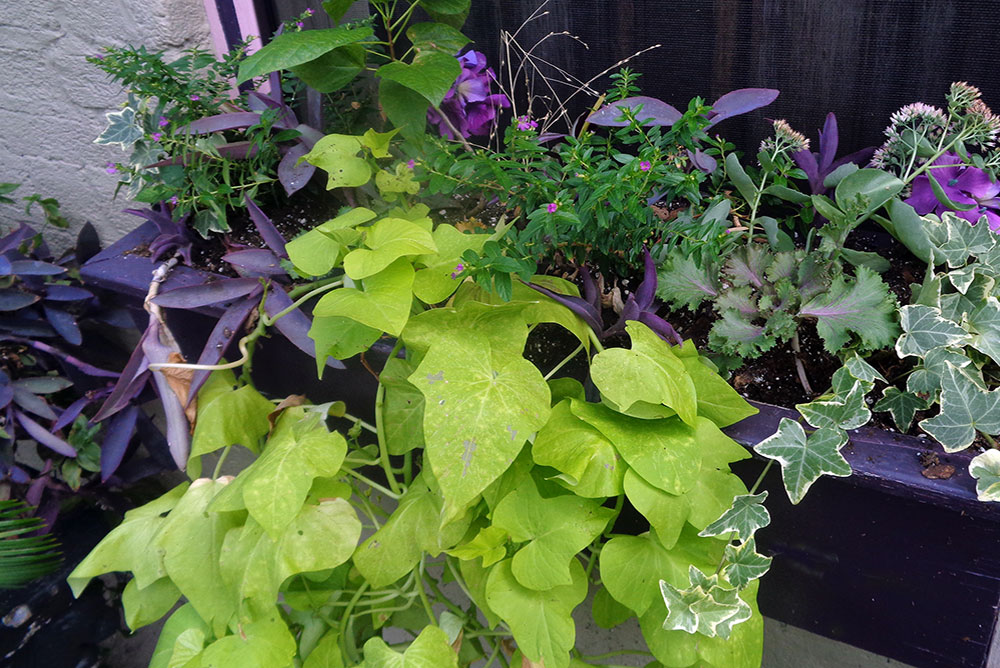
The sweet potato vine is still going strong, but the two small, barely visible, kale plants on either side of it will soon be the stars of the Cavanaugh window box. / Photo by Stephanie Cavanaugh.
SOME YEARS AGO the Washington Post’s fine garden editor scoffed and poo-pooed and stomped about in High British Dudgeon at the proliferation of ornamental cabbages and kale in fall gardens.
I don’t recall exactly what he said, but he expressed immense dislike for the plants and disdain for any gardener who might plant them. Sniff, sniff and so forth.
Oh, let’s toss in another sniff just for the hell of it.
While I’m usually quick to note a trend on the verge of overdone, like those deliberately knocked-over pots spilling out what-have-yous, I had then and I have now an affection—Nay, joy!—at the sight of those leafy, frilly heads of green or purple, or green and purple, or, best of all, purple with hot-pink centers.
I saw them before I even had a garden. They were planted amid a splendid display of chrysanthemums and pansies at a National Symphony Orchestra show house, big fat heads dancing up the path to the doorway of a tiny outbuilding designed by the delightfully named Mrs. McGregor’s Garden Shop, which appears to no longer exist.
One could imagine Peter Rabbit salivating at the sight, though he might spit out the leaves as they are rather bitter, though I’ve read that a leaf or two is tasty in salad. Do let me know.
Such playful fantasy, I thought then, and now.
Is there anything that brings greater cheer to the fall and winter garden? While the edges of kale are frilly and those of cabbages are smooth, both are in the same plant family and will continue to grow through spring, dramatic in scale and color right when you need it most—in the depths of January, when the sky is gray and even those pansies have sighed and drooped, gasping for a little sun and warmth.
We’re at a funny time of year. Fall is here, but the weather is still mild, even hot, so the annuals and tropicals are still happily blooming. Meanwhile, the selection of bulbs and winter-hardy plants is quickly shrinking. This makes for a juggling act, removing plants that might still be looking pretty and replacing them with pansies and such, which will live out the cold.
As the days grow shorter and the air begins to nip, that pretty garden quickly becomes ratty and increasingly bedraggled. Then, one night, a frost strikes and it all goes belly-up in a snap.
Plant now or you’ll be faced with pots of dirt for the coming months.
An antipathy toward ruining what’s pretty now for what will be most attractive later is probably why so many containers and window boxes are left fallow for the cold season. There’s no excuse anywhere south of the frozen tundra of—say Minnesota—for them to sit there looking dead for half a year.
That’s what makes cabbages and kale such jolly additions.
Stick one in the middle of a pot, surround it with pansies, and maybe add a drip of ivy. Done.
In pots, you can start out with large heads of cabbage or kale. They might bolt* before the season is through, though there’s something to be said for instant gratification. But maybe you’ll be lucky and they’ll last until they can be replaced.
For window boxes, keep an eye out for six-packs of very young heads, about the size of a single geranium flower. Unfortunately, these are hard to come by. (You can start some from seed next year, if you’re the sort who does well with them and can figure out the timing and so forth. I am not one of you.)
These smaller heads will not have dense roots and can be easily plopped into a bare space. As they grow they will gradually displace any malingering annuals, which will be looking scruffier by the second as the weather chills.
Or just throw out all the summer stuff and stuff the whole box with them. Magical!
—Stephanie Cavanaugh
*Stop flowering, throw off a stringy stem and set seed. Like basil does, you know?
LittleBird “Stephanie Gardens” adheres to the Art of the Possible when it comes to winter gardening.
